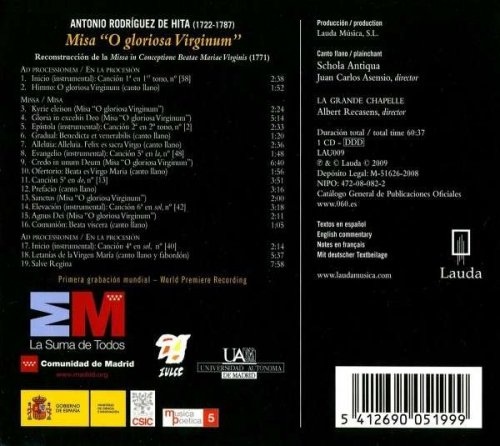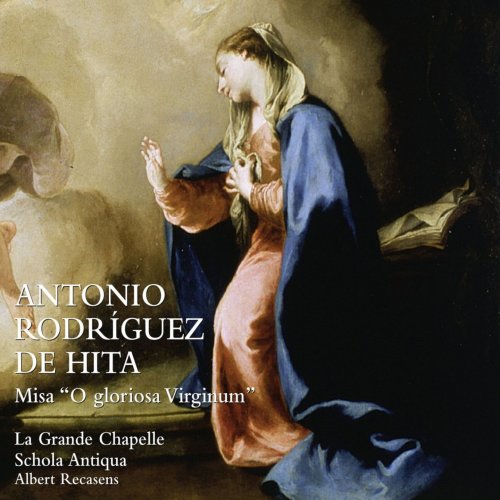
Albert Recasens, La Grande Chapelle, Schola Antiqua - Antonio Rodríguez de Hita: Misa O Gloriosa Virginium (2011)
BAND/ARTIST: Albert Recasens, La Grande Chapelle, Schola Antiqua
- Title: Antonio Rodríguez de Hita: Misa O Gloriosa Virginium
- Year Of Release: 2011
- Label: Lauda Música
- Genre: Classical
- Quality: flac lossless (tracks) +Booklet
- Total Time: 01:00:34
- Total Size: 235 mb
- WebSite: Album Preview
Tracklist
01. En la Procesión: Inicio-Canción 1a, en 1er Tono, No. 58
02. En la Procesión: Himno-O gloriosa Virginium
03. Misa: Kyrie eleison
04. Misa: Gloria in excelsis Deo
05. Misa: Epistola-Canción 2a, en 2 Tono, No. 2
06. Misa :Gradual-Benedicta et venerabilis
07. Misa: Alleluia-Felix es sacra virgo
08. Misa: Evangelio-Canción 5a, en La, No. 48
09. Misa: Credo in unum Deum
10. Misa: Ofertorio-Beata es Virgo Maria
11. Misa: Canción 5a en Do, No. 13
12. Misa: Prefacio
13. Misa: Sanctus
14. Misa: Elevación; Canción 6a, en Sol, No. 42
15. Misa: Agnus Dei
16. Misa: Comunión-Beata Viscera
17. En la procesión: Inicio- Canción 4a en Sol, No. 40
18. En la procesión: Letanías de la Virgen María
19. En la procesión: Salve Regina

Antonio Rodríguez de Hita is one of the most important Spanish musicians and theorists of the 18th century, well known for being the instigator – alongside the dramatist Ramón de la Cruz – of the comic zarzuela. However the majority of his extant work is of a religious nature, written for the Real Monasterio de la Encarnación in Madrid where he was the maestro de capilla between 1765 and 1787 after having occupied similar positions in the iglesia magistral of Alcalá de Henares and in the Cathedral of Palencia.
Of the fifteen masses that have come down to us, Albert Recasens has selected O gloriosa Virginum, written for eight voices and orchestra and composed in 1771 for the celebration of the Immaculate Conception (December 8th). Rodríguez de Hita based the work on the Spanish hymn O gloriosa Virginum. As with most of the religious repertoire of the 18th century in Spain it brings together elements of the polychoral tradition and typical pre-classical flourishes. The mass is a noteworthy example of the musical eclecticism that dominated Spanish church music at that time.
The present recording takes the form of a liturgical reconstruction, with the characteristic alternation of plainsong, vocal-orchestral parts and some instrumental pieces taken from the extraordinary collection Escala diatónico-cromático-enarmónica (1751), which has already been tackled – albeit with a different musical selection – by La Grande Chapelle in LAU 005 (2006). Juan Carlos Asensio (Schola Antiqua) is responsible for the plainsong, although the objective here has not been to recreate the ancient ceremonies with exactitude but rather to give them a coherent didactic form. Some litanies from the Salve Regina complete the recording.
This recording, the world’s first, is of enormous interest for musicologists as it is one of the few examples of the vocal music of Antonio Rodríguez de Hita, a key musician in the history of Spanish music in the 18th century.
01. En la Procesión: Inicio-Canción 1a, en 1er Tono, No. 58
02. En la Procesión: Himno-O gloriosa Virginium
03. Misa: Kyrie eleison
04. Misa: Gloria in excelsis Deo
05. Misa: Epistola-Canción 2a, en 2 Tono, No. 2
06. Misa :Gradual-Benedicta et venerabilis
07. Misa: Alleluia-Felix es sacra virgo
08. Misa: Evangelio-Canción 5a, en La, No. 48
09. Misa: Credo in unum Deum
10. Misa: Ofertorio-Beata es Virgo Maria
11. Misa: Canción 5a en Do, No. 13
12. Misa: Prefacio
13. Misa: Sanctus
14. Misa: Elevación; Canción 6a, en Sol, No. 42
15. Misa: Agnus Dei
16. Misa: Comunión-Beata Viscera
17. En la procesión: Inicio- Canción 4a en Sol, No. 40
18. En la procesión: Letanías de la Virgen María
19. En la procesión: Salve Regina

Antonio Rodríguez de Hita is one of the most important Spanish musicians and theorists of the 18th century, well known for being the instigator – alongside the dramatist Ramón de la Cruz – of the comic zarzuela. However the majority of his extant work is of a religious nature, written for the Real Monasterio de la Encarnación in Madrid where he was the maestro de capilla between 1765 and 1787 after having occupied similar positions in the iglesia magistral of Alcalá de Henares and in the Cathedral of Palencia.
Of the fifteen masses that have come down to us, Albert Recasens has selected O gloriosa Virginum, written for eight voices and orchestra and composed in 1771 for the celebration of the Immaculate Conception (December 8th). Rodríguez de Hita based the work on the Spanish hymn O gloriosa Virginum. As with most of the religious repertoire of the 18th century in Spain it brings together elements of the polychoral tradition and typical pre-classical flourishes. The mass is a noteworthy example of the musical eclecticism that dominated Spanish church music at that time.
The present recording takes the form of a liturgical reconstruction, with the characteristic alternation of plainsong, vocal-orchestral parts and some instrumental pieces taken from the extraordinary collection Escala diatónico-cromático-enarmónica (1751), which has already been tackled – albeit with a different musical selection – by La Grande Chapelle in LAU 005 (2006). Juan Carlos Asensio (Schola Antiqua) is responsible for the plainsong, although the objective here has not been to recreate the ancient ceremonies with exactitude but rather to give them a coherent didactic form. Some litanies from the Salve Regina complete the recording.
This recording, the world’s first, is of enormous interest for musicologists as it is one of the few examples of the vocal music of Antonio Rodríguez de Hita, a key musician in the history of Spanish music in the 18th century.
As a ISRA.CLOUD's PREMIUM member you will have the following benefits:
- Unlimited high speed downloads
- Download directly without waiting time
- Unlimited parallel downloads
- Support for download accelerators
- No advertising
- Resume broken downloads


